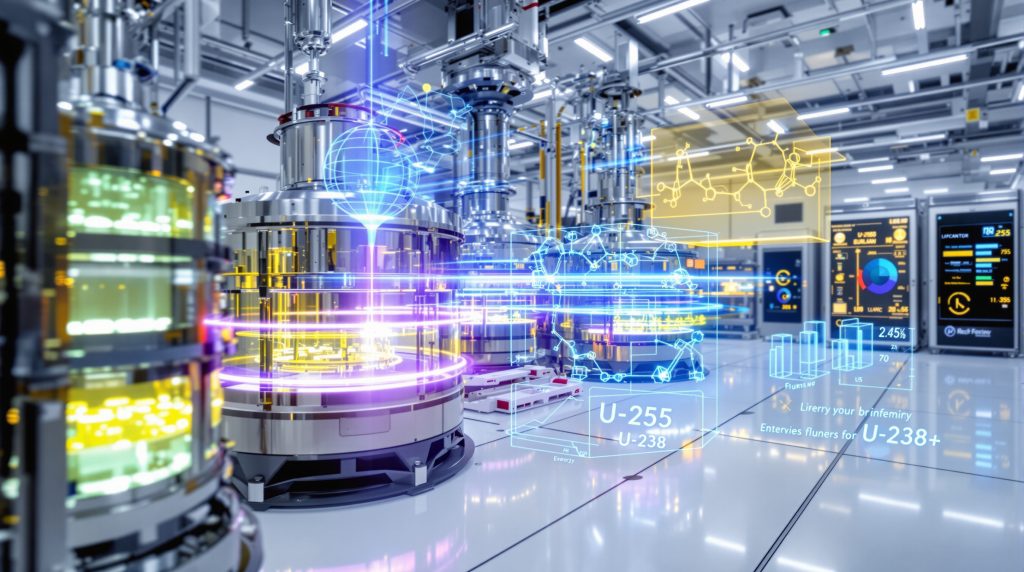What Is Laser-Based Uranium Enrichment and Why Does It Matter?
The nuclear industry stands at a technological crossroads where precision meets power. Laser-based uranium enrichment technology represents a revolutionary departure from traditional mechanical separation methods, utilising photonic energy to selectively target specific uranium isotopes with unprecedented accuracy.
Unlike conventional centrifuge systems that rely on mass differences through high-speed rotation, laser enrichment exploits the unique spectral fingerprints of uranium isotopes. This quantum-level approach promises to reshape nuclear fuel production by offering enhanced efficiency, reduced facility footprints, and potentially lower operational costs.
Recent developments have demonstrated the commercial viability of this approach. SILEX Systems achieved a significant milestone in October 2025 by becoming the first company globally to enrich uranium using laser-based uranium enrichment technology that meets the U.S. Department of Energy's Technology Readiness Level 6 (TRL-6) standard. This certification represents a critical validation that the technology can function reliably in relevant operational environments.
The Science Behind Photonic Isotope Separation
The fundamental principle centres on exciting uranium-235 atoms using precisely calibrated laser frequencies. When exposed to specific wavelengths, U-235 isotopes absorb energy differently than their U-238 counterparts, creating temporary chemical or physical state changes that enable separation.
This molecular-level precision allows operators to achieve enrichment ratios that would require extensive cascade systems in traditional facilities. Furthermore, it potentially reduces both infrastructure requirements and energy consumption significantly.
Which Laser Enrichment Methods Are Currently Being Developed?
Atomic Vapor Laser Isotope Separation (AVLIS)
AVLIS technology vaporises metallic uranium and uses tunable lasers to selectively ionise U-235 atoms. Electromagnetic fields then collect these ionised particles, separating them from neutral U-238 atoms.
Despite technical feasibility demonstrations, AVLIS faces significant commercialisation hurdles due to the complex metallurgy required to convert uranium compounds into vapour-ready metallic forms. In addition, the energy requirements for maintaining uranium in vapour state present additional operational challenges.
Molecular Laser Isotope Separation (MLIS) and SILEX Technology
MLIS operates directly on uranium hexafluoride (UF₆), the standard feedstock used throughout the nuclear fuel cycle. The SILEX (Separation of Isotopes by Laser Excitation) process represents the most commercially advanced iteration of this approach.
Key SILEX Advantages:
• Direct UF₆ processing eliminates conversion steps
• Seamless integration with existing fuel cycle infrastructure
• Demonstrated scalability through large-scale testing facilities
• Potential for modular facility design
The achievement of TRL-6 certification by SILEX demonstrates that third-generation laser-based uranium enrichment technology can operate at industrial scales while meeting stringent government standards. However, this milestone effectively de-risks the commercialisation pathway for laser enrichment applications.
| Technology | Feed Material | Development Stage | Commercial Viability |
|---|---|---|---|
| AVLIS | Uranium Metal | Research Phase | Limited |
| MLIS/SILEX | Uranium Hexafluoride | Pre-Commercial | High |
| Traditional Centrifuge | Uranium Hexafluoride | Commercial | Established |
How Does Laser Enrichment Compare to Traditional Methods?
Energy Efficiency and Environmental Impact
Laser-based uranium enrichment technology systems theoretically require significantly less electrical power per separative work unit compared to gaseous diffusion plants, which were phased out due to enormous energy consumption. Early projections suggest SILEX could achieve 50-80% energy savings compared to first-generation enrichment technologies.
The reduced physical footprint also translates to lower construction materials, smaller land requirements, and potentially decreased environmental disruption during facility development. For instance, this compact design philosophy aligns with modern nuclear industry trends toward smaller, more efficient installations.
Operational Complexity and Maintenance Requirements
While centrifuge facilities require thousands of spinning units operating in synchronised cascades, laser systems concentrate separation power into fewer, more sophisticated components. This concentration potentially reduces mechanical failure points but increases dependence on precision optical equipment.
Maintenance Considerations:
• Laser calibration and alignment requirements
• Optical component replacement schedules
• UF₆ handling system compatibility
• Automated process control sophistication
The technical complexity of laser-based uranium enrichment technology demands specialised expertise in photonics, precision manufacturing, and nuclear materials handling. Nevertheless, the reduced number of moving parts compared to centrifuge cascades may ultimately simplify long-term maintenance protocols.
What Are the Current Commercial Development Status and Timeline?
Global Laser Enrichment Progress in North America
The most advanced commercial laser enrichment programme operates through Global Laser Enrichment, a partnership involving major nuclear industry players. Their Wilmington, North Carolina test facility has successfully demonstrated large-scale uranium production, processing hundreds of pounds of material and validating industrial-scale feasibility.
SILEX Systems is currently developing the Paducah Laser Enrichment Facility (PLEF) in Kentucky, which would represent the only uranium enrichment facility under construction in the United States according to nuclear regulatory records. This facility could potentially process over 200,000 metric tons of uranium tails annually, significantly boosting domestic enrichment capacity whilst reducing dependence on international suppliers.
Regulatory Approval and Technology Readiness Levels
The achievement of TRL-6 certification represents a watershed moment for laser-based uranium enrichment technology. This third-party validation confirms the technology can operate reliably in relevant environments and is approaching commercial deployment readiness.
Current regulatory status includes:
• Licensed enrichment up to 8% U-235 concentration
• Ongoing discussions for higher enrichment authorisations
• Environmental impact assessments for commercial facilities
• International safeguards integration protocols
SILEX CEO Michael Goldsworthy noted that the company stands as the only organisation globally to demonstrate large-scale, third-generation laser-based enrichment technology at TRL-6 status. This unique position provides significant competitive advantages in the emerging laser enrichment market.
What Are the Strategic Implications for Nuclear Fuel Supply Chains?
Geopolitical Considerations and Supply Security
The global uranium enrichment market currently depends heavily on Russian and European centrifuge facilities. However, us uranium market disruption concerns are driving Western nations to develop alternative supply sources and reduce strategic vulnerabilities in nuclear fuel production.
Successful commercialisation could reshape international nuclear trade relationships, particularly as countries seek to secure domestic fuel cycle capabilities amid geopolitical tensions. The compact nature of laser facilities enables distributed production networks that enhance supply chain resilience.
Next-Generation Reactor Compatibility
Advanced reactor designs, including small modular reactors (SMRs) and Generation IV systems, may require specialised fuel compositions that laser enrichment can produce more efficiently than traditional methods. SILEX has specifically identified next-generation reactors, including small modular designs, as target markets for its enrichment technology.
The precision control offered by laser systems could enable:
• Custom enrichment levels for specific reactor designs
• Reduced waste generation through precise isotope targeting
• Flexible production scheduling to match demand fluctuations
• Potential for co-location with reactor facilities
Moreover, the development of us uranium production tech demonstrates growing domestic capability across the fuel cycle.
What Challenges and Risks Does Laser Enrichment Face?
Technical and Economic Hurdles
Despite promising demonstrations, laser-based uranium enrichment technology still faces significant scaling challenges. The transition from laboratory success to industrial-scale production requires overcoming multiple technical and economic barriers.
Key challenges include:
• Laser system reliability over extended operational periods
• Cost competitiveness with mature centrifuge technology
• Skilled workforce development for specialised operations
• Integration with existing nuclear fuel supply chains
The complexity of maintaining precise laser calibration over continuous industrial operations presents ongoing technical challenges. Additionally, the specialised nature of photonic enrichment equipment may initially limit supplier networks and increase maintenance costs.
Proliferation and Security Concerns
The efficiency and compact nature of laser enrichment facilities raise unique nonproliferation challenges. Unlike centrifuge plants that require large, detectable cascade halls, laser facilities could potentially operate with smaller footprints and reduced detectability.
Security considerations include:
• Enhanced safeguards monitoring requirements
• Technology transfer restrictions
• Facility design transparency obligations
• International oversight protocol development
"The smaller facility footprint that makes laser enrichment economically attractive also complicates traditional monitoring approaches used by international nuclear watchdog organisations."
International regulatory bodies continue developing specialised oversight frameworks to address the unique characteristics of laser-based uranium enrichment technology whilst preserving its commercial potential. Consequently, nuclear waste disposal safety measures become even more crucial for comprehensive nuclear security.
How Will Laser Enrichment Technology Shape the Nuclear Industry's Future?
Market Transformation Potential
Successful laser-based uranium enrichment technology commercialisation could fundamentally alter nuclear fuel economics by reducing barriers to entry for new suppliers and enabling more distributed production networks. This technological shift may accelerate nuclear power expansion by improving fuel security and reducing costs.
The modular nature of laser systems could enable smaller nations to develop domestic enrichment capabilities without the massive infrastructure investments required for centrifuge facilities. This democratisation of enrichment technology may reshape global nuclear fuel markets significantly.
SILEX projects that its uranium enrichment technology could become a major contributor to nuclear fuel production for both current and future nuclear reactor fleets. However, this depends on industry support, feasibility assessments, and favourable market conditions.
Innovation Catalyst Effects
Laser-based uranium enrichment technology development is driving advances in precision optics, process control systems, and materials science that extend beyond nuclear applications. These technological spillovers could benefit industries ranging from semiconductor manufacturing to medical isotope production.
The success of laser enrichment may also accelerate research into other advanced separation technologies, potentially revolutionising how various industries approach isotope production and purification processes.
Recent market responses demonstrate investor confidence in the technology's commercial potential. SILEX shares rose over 10% following the TRL-6 announcement, reflecting market recognition of this technological milestone's significance.
Investment Considerations and Market Dynamics
Commercial Viability Assessment
The TRL-6 certification achieved by SILEX represents a crucial de-risking milestone for laser-based uranium enrichment technology investments. This third-party validation confirms the technology's readiness for commercial deployment, potentially attracting additional industry investment and partnerships.
Current market positioning indicates SILEX trading at $8.62 per share with a market capitalisation of $2.371 billion, reflecting investor confidence in the technology's commercial prospects. The company's unique position as the only organisation demonstrating large-scale laser enrichment at TRL-6 status provides significant competitive advantages.
Strategic Partnership Opportunities
The complexity and capital requirements of laser enrichment facilities create natural opportunities for strategic partnerships between technology developers, utilities, and government entities. SILEX's approach of developing both the technology and potential uranium production capabilities offers multiple commercialisation pathways.
Companies can potentially monetise laser-based uranium enrichment technology through:
• Technology licensing agreements
• Direct uranium production and sales
• Joint venture facility development
• Government contract fulfilment
Recent developments in the volatile uranium market create additional opportunities for strategic positioning, particularly as the paladin uranium mining halt demonstrates supply chain vulnerabilities.
Regulatory Framework Evolution
International Standards Development
The emergence of commercial laser-based uranium enrichment technology requires updated international regulatory frameworks to address unique operational characteristics and security considerations. Current regulations primarily address centrifuge and gaseous diffusion technologies.
Regulatory bodies must balance promoting technological innovation with maintaining robust nonproliferation safeguards. The compact nature of laser facilities necessitates new monitoring approaches and transparency requirements.
Domestic Policy Implications
National energy security considerations drive policy support for domestic uranium enrichment capabilities. The United States currently relies heavily on foreign suppliers for enriched uranium, creating strategic vulnerabilities that laser-based uranium enrichment technology could help address.
Policy frameworks supporting domestic enrichment include:
• Research and development funding programmes
• Regulatory streamlining for advanced technologies
• Government procurement preferences
• Tax incentives for domestic production facilities
Technical Implementation Challenges
Precision Manufacturing Requirements
Laser-based uranium enrichment technology demands extremely precise optical components capable of maintaining calibration over extended operational periods. Manufacturing tolerances for laser systems exceed those required for traditional enrichment equipment.
Critical technical specifications include:
• Wavelength stability within nanometre precision
• Optical component durability under UF₆ exposure
• Automated calibration and alignment systems
• Real-time performance monitoring capabilities
Workforce Development Needs
The specialised nature of laser enrichment operations requires workforce expertise spanning photonics, nuclear engineering, and precision manufacturing. Educational institutions and training programmes must develop curricula addressing these multidisciplinary requirements.
Skills gaps in laser-based uranium enrichment technology include:
• Optical system design and maintenance
• Nuclear materials handling procedures
• Process control system operation
• Safety protocol implementation
Furthermore, the integration with existing nuclear infrastructure requires comprehensive understanding of laser isotope separation techniques and their practical applications.
The information contained in this article is for educational purposes only and should not be construed as investment advice. Uranium enrichment technologies involve complex technical, regulatory, and market factors that require professional evaluation. Readers should conduct independent research and consult qualified advisors before making investment decisions related to nuclear technology companies or uranium market exposure.
Interested in Uranium Enrichment Investment Opportunities?
Discovery Alert's proprietary Discovery IQ model delivers real-time alerts on significant uranium and nuclear technology discoveries, instantly empowering subscribers to identify actionable opportunities ahead of the broader market. Begin your 30-day free trial today and secure your market-leading advantage in this rapidly evolving sector.




